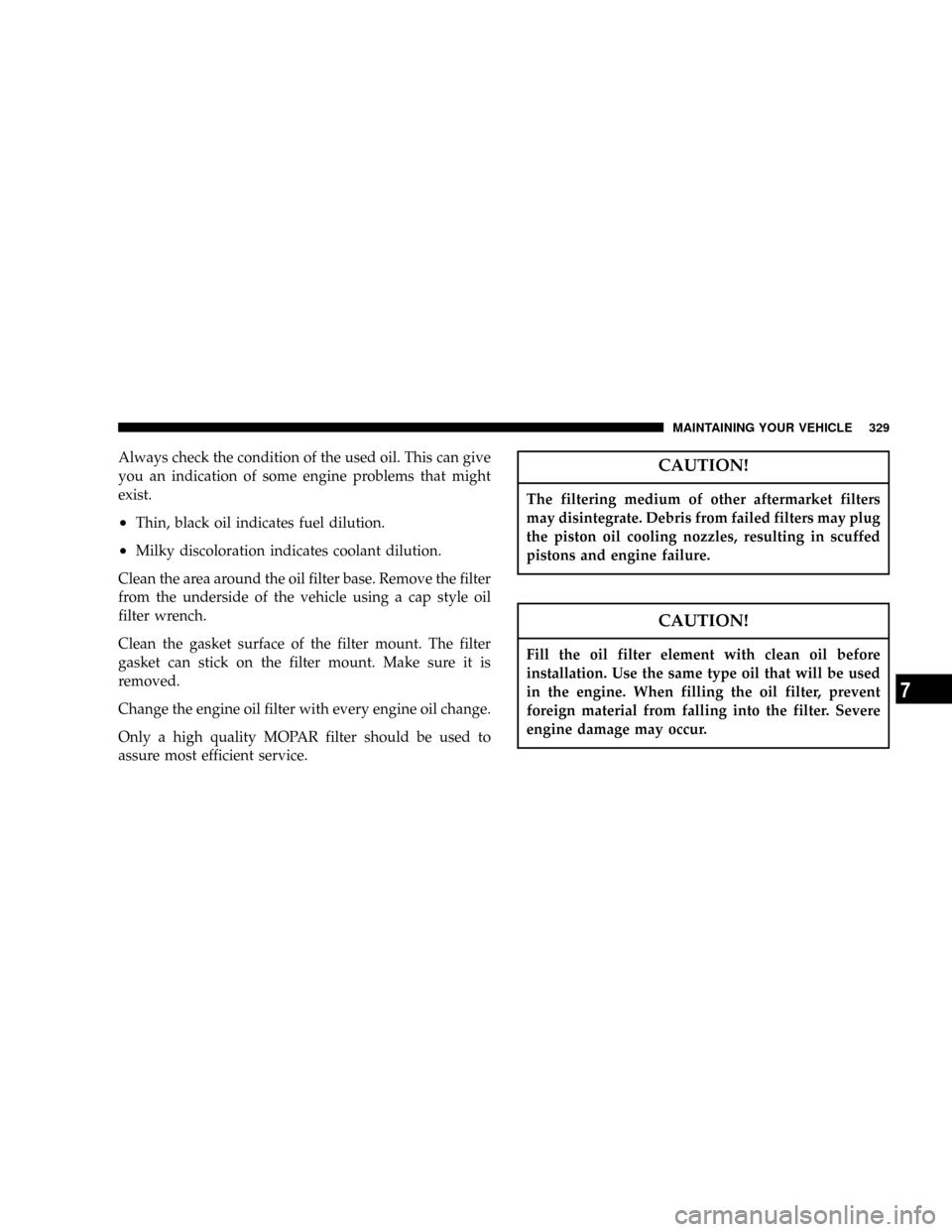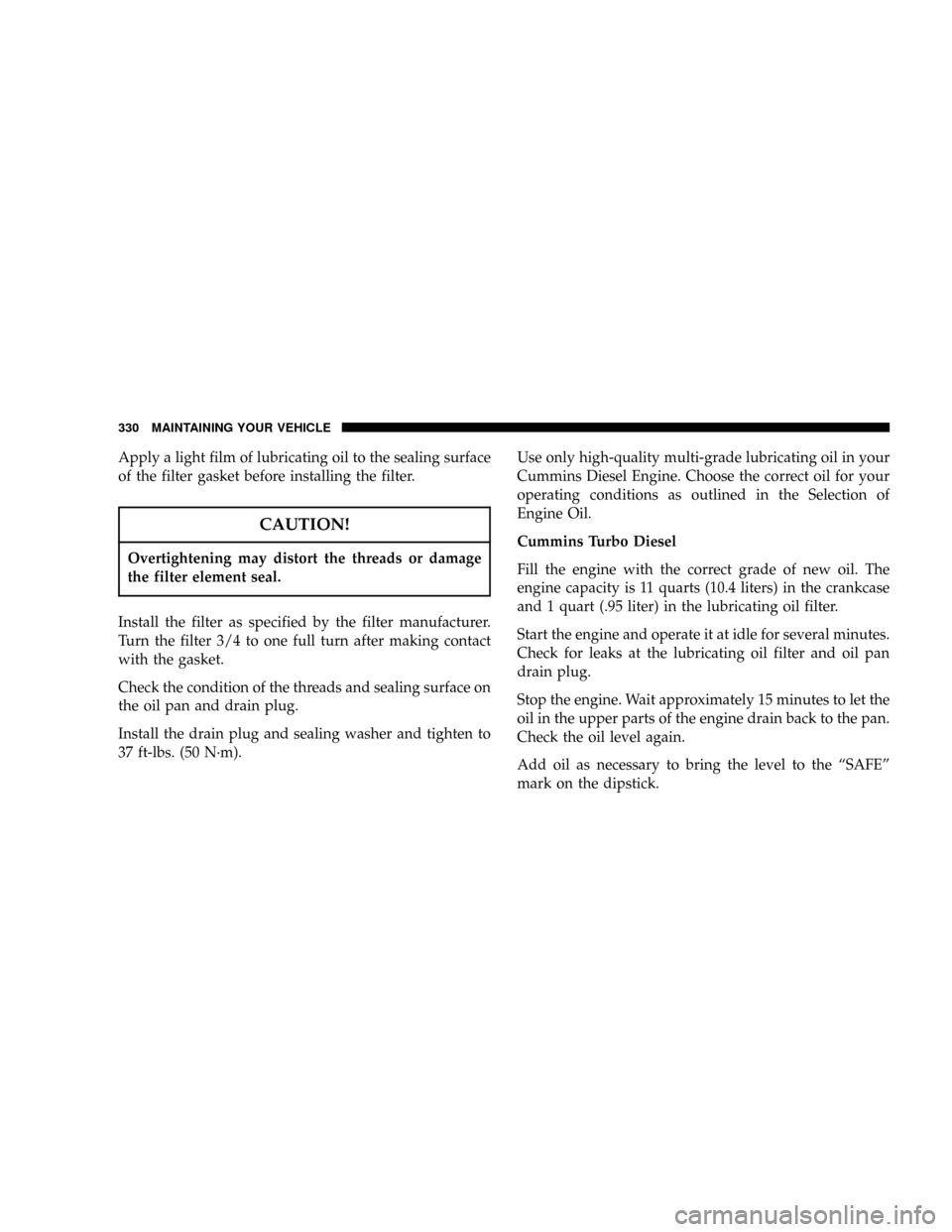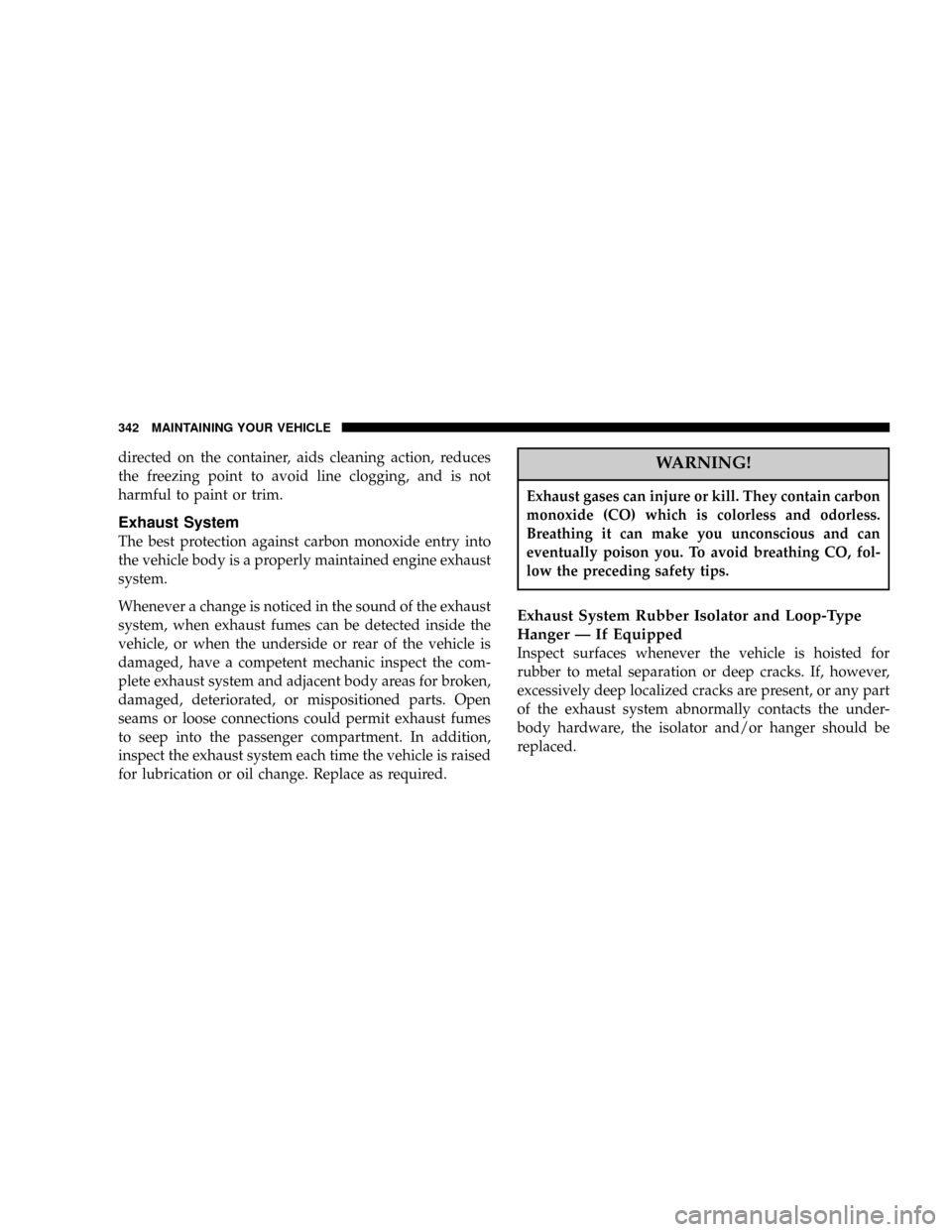Page 328 of 426
NOTE:The same oil change interval is to be followed
for synthetic oil as for petroleum based oil. Also, syn-
thetic oil must meet the same performance specifications
as petroleum oil.Engine Oil Filter
Refer to Recommended Fluids, Lubricants and Genuine
Parts for the correct part number. The engine oil filter
should be changed ateveryengine oil change.
Engine Oil And Filter Ð Change
WARNING!
Hot oil can cause personal injury.
Operate the engine until the coolant temperature reaches
140ÉF (60ÉC). Shut the engine off. Remove the oil drain
plug.
Use a container that can hold at least 12 quarts (11.3
Liters) to hold the used oil.
328 MAINTAINING YOUR VEHICLE
Page 329 of 426

Always check the condition of the used oil. This can give
you an indication of some engine problems that might
exist.
²Thin, black oil indicates fuel dilution.
²Milky discoloration indicates coolant dilution.
Clean the area around the oil filter base. Remove the filter
from the underside of the vehicle using a cap style oil
filter wrench.
Clean the gasket surface of the filter mount. The filter
gasket can stick on the filter mount. Make sure it is
removed.
Change the engine oil filter with every engine oil change.
Only a high quality MOPAR filter should be used to
assure most efficient service.
CAUTION!
The filtering medium of other aftermarket filters
may disintegrate. Debris from failed filters may plug
the piston oil cooling nozzles, resulting in scuffed
pistons and engine failure.
CAUTION!
Fill the oil filter element with clean oil before
installation. Use the same type oil that will be used
in the engine. When filling the oil filter, prevent
foreign material from falling into the filter. Severe
engine damage may occur.
MAINTAINING YOUR VEHICLE 329
7
Page 330 of 426

Apply a light film of lubricating oil to the sealing surface
of the filter gasket before installing the filter.
CAUTION!
Overtightening may distort the threads or damage
the filter element seal.
Install the filter as specified by the filter manufacturer.
Turn the filter 3/4 to one full turn after making contact
with the gasket.
Check the condition of the threads and sealing surface on
the oil pan and drain plug.
Install the drain plug and sealing washer and tighten to
37 ft-lbs. (50 N´m).Use only high-quality multi-grade lubricating oil in your
Cummins Diesel Engine. Choose the correct oil for your
operating conditions as outlined in the Selection of
Engine Oil.
Cummins Turbo Diesel
Fill the engine with the correct grade of new oil. The
engine capacity is 11 quarts (10.4 liters) in the crankcase
and 1 quart (.95 liter) in the lubricating oil filter.
Start the engine and operate it at idle for several minutes.
Check for leaks at the lubricating oil filter and oil pan
drain plug.
Stop the engine. Wait approximately 15 minutes to let the
oil in the upper parts of the engine drain back to the pan.
Check the oil level again.
Add oil as necessary to bring the level to the ªSAFEº
mark on the dipstick.
330 MAINTAINING YOUR VEHICLE
Page 331 of 426

Disposing Of Used Engine Oil And Filter
Care should be taken in disposing of the used engine
fluids from your vehicle. Used fluids, indiscriminately
discarded, can present a problem to the environment.
Contact your local dealer, service station, or governmen-
tal agency for advice on recycling programs and where
used fluids and filters can be safely discarded in your
area.
Drive Belt
Inspection
Check the belt for intersecting cracks.
²Transverse (across the belt width) cracks are accept-
able.
²Longitudinal (direction of belt length) cracks that
intersect with transverse cracks are NOT acceptable.Replace the belt if it has unacceptable cracks, is frayed or
has pieces of material missing.
The engine speed sensor, located near the damper, should
be inspected for damage if a belt is frayed.
Engine Air Cleaner Filter
CAUTION!
All air entering the engine intake must be filtered.
The abrasive particles in unfiltered air will cause
rapid wear to engine components.
The air filter housing on your Diesel Ram is equipped
with a Filter MinderŸ. This is an air flow restriction
gauge that will indicate when the filter element needs to
be replaced.
MAINTAINING YOUR VEHICLE 331
7
Page 333 of 426
A visual inspection of the air cleaner filter element is
never recommended under normal circumstances. A
badly restricted element may appear clean while a soiled
element may be quite effective in filtering particles
without restricting air flow. Rely on the Filter MinderŸ
to determine when a filter change is necessary.
After a new filter element is inserted, press the rubber
button on the top of the Filter MinderŸ. This action will
reset the yellow disc to the clean position.CAUTION!
When using an engine cleaner or a degreaser, be sure
to wrap and tape the Filter MinderŸ to protect the
plastic housing from damage and discoloration.
NOTE:Many aftermarket performance air filter ele-
ments do not adequately filter the air entering the engine.
Use of such filters can severely damage your engine and
such damage is not covered by the manufacturer's war-
ranty.
MAINTAINING YOUR VEHICLE 333
7
Page 339 of 426

Refrigerant Recovery and Recycling
R-134a Air Conditioning Refrigerant is a hydrofluorocar-
bon (HFC) that is endorsed by the Environmental Pro-
tection Agency and is an ozone-saving product. How-
ever, the manufacturer recommends that air conditioning
service be performed by dealers or other service facilities
using recovery and recycling equipment.
NOTE:Air Conditioning systems found to be contami-
nated with A/C System Sealers, Stop Leak Products, Seal
Conditioners, Compressor Oil, or Refrigerants not ap-
proved by the manufacturer, voids the warranty for the
Air Conditioning system.
Power Steering Ð Fluid Check
Checking the power steering fluid level at a defined
service interval is not required. The fluid should only be
checked if a leak is suspected, abnormal noises areapparent, and/or the system is not functioning as antici-
pated. Coordinate inspection efforts through a certified
DaimlerChrysler Dealership.9
WARNING!
Fluid level should be checked on a level surface and
with the engine off to prevent injury from moving
parts and to insure accurate fluid level reading. Do
not overfill. Use only manufacturers recommended
power steering fluid.
If necessary, add fluid to restore to the proper indicated
level. With a clean cloth, wipe any spilled fluid from all
surfaces. Refer to Recommended Fluids, Lubricants, and
Genuine Parts for correct fluid type.
MAINTAINING YOUR VEHICLE 339
7
Page 341 of 426

Windshield Wiper Blades
The rubber edges of the wiper blades and the windshield
should be cleaned periodically with a sponge or soft cloth
and a mild nonabrasive cleaner. This will remove accu-
mulations of salt or road film.
Operation of the wipers on dry glass for long periods
may cause deterioration of the wiper blades. Always use
washer fluid when using the wipers to remove salt or dirt
from a dry windshield.
Avoid using the wiper blades to remove frost or ice from
the windshield. Keep the blade rubber out of contact with
petroleum products such as engine oil, gasoline, etc.
Windshield Washers
The fluid reservoir is located under the hood and should
be checked for fluid level at regular intervals. Fill the
reservoir with windshield washer solvent only (not ra-
diator antifreeze).To prevent freeze-up of your windshield washer system
in cold weather, select a solution or mixture that meets or
exceeds the temperature range of your climate. This
rating information can be found on most washer fluid
containers.
WARNING!
Commercially available windshield washer solvents
are flammable. They could ignite and burn you. Care
must be exercised when filling or working around
the washer solution.
After the engine has warmed, operate the defroster for a
few minutes to reduce the possibility of smearing or
freezing the fluid on the cold windshield. Mopar All
Weather Windshield Washer Solution, used with water as
MAINTAINING YOUR VEHICLE 341
7
Page 342 of 426

directed on the container, aids cleaning action, reduces
the freezing point to avoid line clogging, and is not
harmful to paint or trim.
Exhaust System
The best protection against carbon monoxide entry into
the vehicle body is a properly maintained engine exhaust
system.
Whenever a change is noticed in the sound of the exhaust
system, when exhaust fumes can be detected inside the
vehicle, or when the underside or rear of the vehicle is
damaged, have a competent mechanic inspect the com-
plete exhaust system and adjacent body areas for broken,
damaged, deteriorated, or mispositioned parts. Open
seams or loose connections could permit exhaust fumes
to seep into the passenger compartment. In addition,
inspect the exhaust system each time the vehicle is raised
for lubrication or oil change. Replace as required.
WARNING!
Exhaust gases can injure or kill. They contain carbon
monoxide (CO) which is colorless and odorless.
Breathing it can make you unconscious and can
eventually poison you. To avoid breathing CO, fol-
low the preceding safety tips.
Exhaust System Rubber Isolator and Loop-Type
Hanger Ð If Equipped
Inspect surfaces whenever the vehicle is hoisted for
rubber to metal separation or deep cracks. If, however,
excessively deep localized cracks are present, or any part
of the exhaust system abnormally contacts the under-
body hardware, the isolator and/or hanger should be
replaced.
342 MAINTAINING YOUR VEHICLE